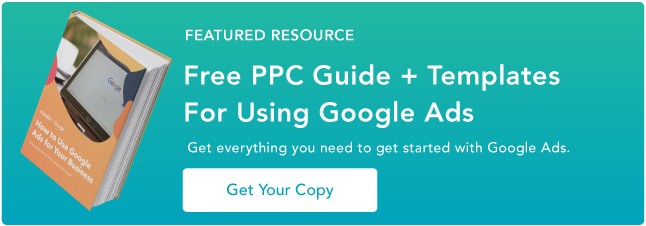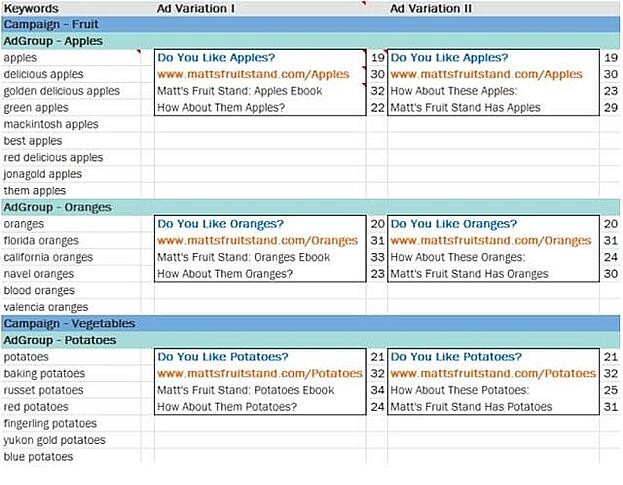In the world of search engine marketing (SEM), more and more marketers are buying into PPC campaigns. Google Ads specifically has increased its revenue from year to year. In 2021, Google advertising revenue accounted for $53.1 billion — 81% of Alphabet's overall sales.
Properly investing in PPC can result in nearly guaranteed ad placement in the search engine result pages of their choice. And this placement can help generate leads. If your ads tool is tightly integrated with your CRM, you can even leverage ads data to nurture these leads across their buyer's journey.
As you prepare to create a PPC campaign, it's important to get a rundown of what a successful campaign entails and identify management missteps that you'll want to avoid.
Building a successful PPC campaign includes a few key steps:
- Determine your PPC campaign structure.
- Identify, build, and refine your campaign's landing pages.
- Create a keyword strategy based on your research.
- Create ads based on insights from the steps above.
- Share your campaign plan with stakeholders.
The problem is, many marketers have poor PPC campaign management, which ends up costing them way more money than they need to spend and delivering underwhelming lead generation results.
Here are a few ways marketers could go wrong with PPC campaign management:
- Coming up with keywords on the fly without doing prior research.
- Only building one basic campaign without utilizing Google Ads' Ad Groups tool.
- Attaching unengaging landing pages — or a homepage that generates no leads — to the campaign.
- Not adding "negative keywords" or monitoring campaigns to avoid wasting budget.
- Creating campaigns, setting budget caps, and going live without telling internal or external stakeholders.
So, how do you manage a PPC campaign properly so that you get leads at a reasonable cost? It comes down to intelligent campaign structure.
How do you master intelligent campaign structure? You use a template!
PPC Plan Template
We've created a free PPC campaign management template that will help you and your clients set up a full-funnel campaign structure that follows PPC best practices. Once you do that, you'll be better positioned to maximize the return on your PPC investment.
If you're running PPC campaigns for someone who doesn't understand the importance of an organized campaign structure, this template will also act as a PPC campaign management task checklist that will enlighten your boss or clients.
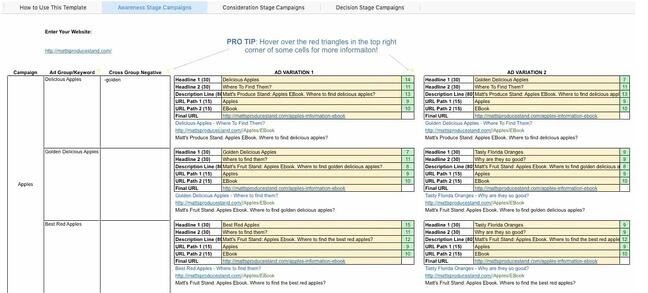
We're going to show you how to use that PPC template in this blog post — so download it now and follow along.
Steps for Using This Template
Before we get started, let's go over a few tips that'll make using this template even easier:
- You will want to clear out the example data I have in the template such as keywords, campaign and AdGroup names, ads, and destination URLs.
- Be careful not to erase columns E, G, and I. They contain formulas that will help you in subsequent steps.
- Click on the red markers in the top corners of the cells. They contain helpful tips and FAQs. If you ever forget what a cell is used for, they will remind you.
Step 1: Choose your PPC campaign management tools and software.
There are several places to begin your PPC campaign strategy, but my advice would be to start with one platform and expand to another until you cover each channel your audience visits. This tactic works because it keeps your costs low in the initial stages of PPC planning. Rather than paying for an external campaign management tool, you can manage your campaigns natively within the platform on which you're running the ads.
However, as you expand your strategy to include more sites, you'll want to scale to a PPC campaign management software that can help you keep track of each platform, each budget, and each set of creative all in one place.
Here are some of our favorite tools for the job:
- Marin Software: Integrates with Google and Facebook — two of the most popular PPC platforms.
- Wordstream Advisor: Analyzes Google and Facebook ad spend for you to keep you on budget.
- SpyFu: Analyze your competitor's campaigns to build a well-rounded strategy.
Step 2: Understand PPC campaign structure.
Before we do anything with this template, it's important to understand PPC campaign structure. Far too many marketers will just set up an account, create an ad, direct the ad to their home page, pick some keywords and hit go. This is not the way to do things.
With Google Ads, you have the opportunity to create multiple campaigns. Each campaign may contain several AdGroups, and each AdGroup may contain a few ads and multiple, similar keywords.
It's wise to create multiple campaigns because you can set daily budget caps, day-parting, and select geo-targeted regions at the campaign level. If you're bidding on generic keywords and branded keywords, you'll want to put these in separate campaigns because the economics around these two types of keywords will likely be very different.
As you can see, your template reflects these best practices, providing space for several different campaigns, AdGroups, and ad variations within those AdGroups.
Step 3: Identify your landing pages.
The "Destination URL" is the place on your website where you want the PPC traffic to end up. Because there is a marginal cost associated with each PPC visitor you attract, I recommend you choose a landing page URL as your destination URL.
Do not drive them to your home page or a blog in hopes that they will stumble upon a lead generation form. That's the job of organic search. Drive them to a landing page with a form on it. Don't forget to put in a tracking token so you know where these leads are coming from.
You will notice that the Destination URL within the AdGroup is the same regardless of the keyword or ad. If you really want to drive a keyword to a different landing page, then create another AdGroup. If you want to get even more specific, create another campaign for that keyword.
You should also keep your sales funnel in mind when you identify these landing pages. Think about which part of the sales funnel each landing page and offer speaks to.
For example, an educational PDF about an industry concept would be appropriate for a top-of-the-funnel offer, while a coupon or a demo would be at the bottom of the funnel.
Manage and create separate campaigns for each part of the funnel. If you scroll down in your template, you'll see that there's dedicated space allotted for campaigns in all of these funnel stages.
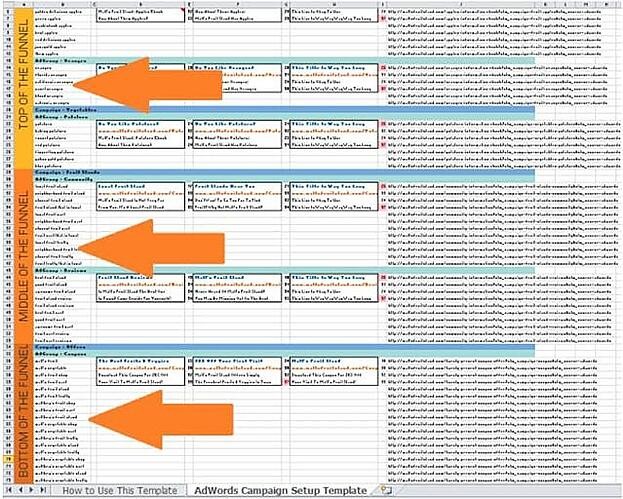
Step 4: Build your keyword strategy.
Next, select the keywords that are relevant to the landing page and offer. Make sure to keep them as relevant as possible to increase the chance that each visitor you pay for completes the form on the landing page.
Yes, it would be nice to rank for certain keywords, but if the landing page doesn't answer the keyword query, think twice. Or better yet, create another offer and landing page that speaks more directly to the keyword.
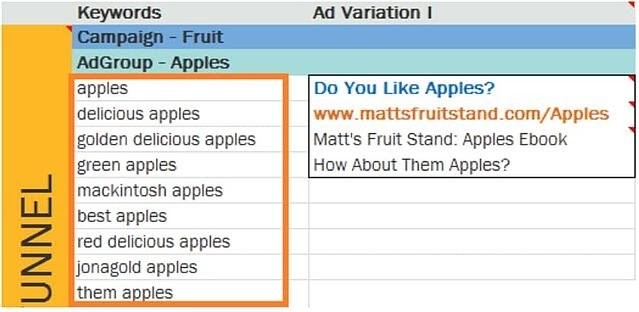
To understand search volumes and costs around each keyword you want to select, you can use free tools like the Google Ads Keyword Tool or — if you're a HubSpot customer — our keywords tool.
If this is your first time managing a PPC campaign, it would be wise to read up on how to design a keyword strategy. In the case of Google Ads, you might also want to learn more about keyword quality scores.
Step 5: Create your ads.
This is the fun part! Both Google Ads and Microsoft Ads allow you to create more than one ad for each Ad Group (hence the "group" terminology). The service will rotate them until it notices that one appears to drive a higher clickthrough rate (CTR). This is how A/B (and C and D) testing works. While this is optional, you should take advantage of the ability to create more than one ad.
Keep in mind that you are allotted 25 characters for the title of the ad, 35 characters for the display URL (the URL that's displayed in the ad, not to be confused with the destination URL), and 35 characters for each line of copy. But if you're using this template, we'll keep track of that for you.
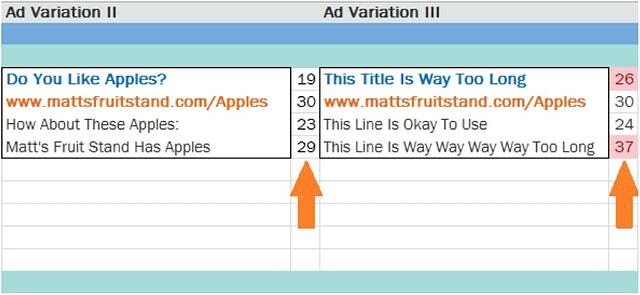
In my experience, the title has the greatest influence on an ad's CTR. It's wise to include a keyword in the headline to draw a user's attention to your ad. An even better practice would be to use dynamic keyword insertion.
A good rule of thumb is to simply try to provide a cohesive experience for searchers — from seeing your ad in the search engine results to completing the form on your landing page — everything should align with the goal of getting them to click through.
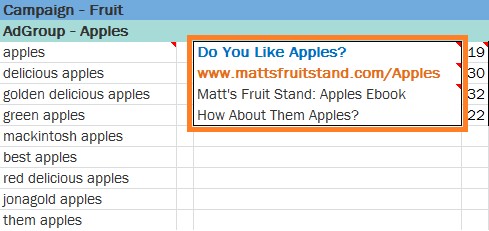
Finally, there's the tricky matter of the display URL. You're only allowed 35 characters here, but it's unlikely that your destination URL, the actual URL for your landing page, will be that short. So the search engines allow you to create a display URL, which may not even be an actual URL on your website. The domain in your display URL must be the same as the domain in your destination URL so that users end up in the right place when they click.
Step 6: Share the completed template with stakeholders.
Whether you're doing PPC for your business or a client, your completed template will ensure alignment between the stakeholders' expectations with the realities of a productive PPC campaign. If you're the stakeholder of a PPC campaign, this template will help you think about what you're doing with the money you're spending on PPC.
By doing so, you'll have created a congruous user experience that search engines like to see. This can benefit you in terms of your positioning in the SERPs and, ultimately, your costs. It will also grant you the agility you need to swiftly reallocate and modify your budget as you respond to changes in the marketplace, and drive the maximum return on your PPC spend.
PPC Campaign Management
Understanding where your audience is spending most of their time online is key, in addition to figuring what kind of ads work best for your business. It’s imperative to familiarize yourself with the different platforms available to run your PPC campaigns. Let’s continue by looking at some of the most prominent online ad platforms: Google, Microsoft (Bing), Facebook, Twitter, and YouTube.
Google PPC Campaign Management
Google has been the dominant player in the search engine space for more than 20 years and it still produces some of the most innovative ad experiences on the market. Here's a look at a couple of the most popular ways to serve ads on Google.
Google Search Ads
One of the most popular types of Google ads is the search ad. These ads appear at the top and bottom of the search results for specific keywords that you bid on. Google search ad campaigns are usually run with the goal of driving traffic to a specific webpage — like a landing or product page.
Google Display Ads
Have you ever visited a website that has advertising on the banner, sidebar, or footer of the page? Then you've probably crossed paths with a Google display ad. These types of ads are typically visual, featuring colorful graphics, videos, and sometimes audio. Google display ads are helpful for retargeting customers who have visited your website before without making a purchase.
Microsoft Ads (Formerly Bing Ads) PPC Campaign Management
Overall, Microsoft Ads works very similarly to Google Ads. However, here are a few tips that can help get the most out of your PPC campaign strategy for Microsoft Ads.
Bing Keyword Suggestions
If the bulk of your PPC efforts live in Google Ads and you decide to start bidding on Microsoft Ads, you might be tempted to use the same keywords that you’re already bidding on in Google. The issue here is that Google and Bing are different search engines and it’s possible that your Google keywords won’t see the same search volume in Bing.
Bing’s keyword research and suggestion tool will give you more accurate search volumes for your keywords. You can still use your original list of keywords from Google to start with, but utilize this tool to verify whether you should be bidding on the same keywords, or something similar that yields more traffic.
Lower CPC
Ad bids can end up being quite costly for a business so many marketers are constantly working to decrease ad spend. Wordstream tested the cost of running ads on both search engines and found that Bing’s average CPC was 33% lower than Google's. Since bidding on Microsoft Ads is less competitive in comparison to Google, it’s likely that you won’t end up spending as much of your budget on this platform.
So if you’re able to find a high MSV keyword to bid on there’s a good chance that you’ll see a positive shift in your return on investment. This may be especially true for specific industries. The table below shows the average industry CPC according to Microsoft Ads.
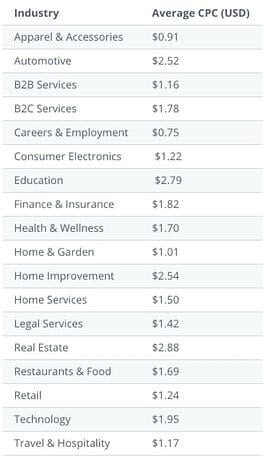
For a deeper dive into Microsoft Ads check out this tutorial.
Facebook PPC Campaign Management
Facebook Ads Manager is a platform that connects 1.6 billion people worldwide to businesses on Facebook. It’s a great tool to target specific audiences and to promote brand presence.
Some of the most popular ads you can incorporate into your Facebook campaigns are:
Story Ads
Stories are thriving on social media platforms, so why not develop a few ads to meet your audience where they’re already spending time?
Stories are only posted for 24 hours so these types of ads are best to use when you have a specific promotion occurring. Like personal stories, story ads can be shared in the form of a video with a link or a series of still photos that lead the viewer to take a specific action.
Playable Ads
Gamification is always an innovative way to catch a lead’s attention. Facebook’s playable ads allow you to create a brief interactive version of a game or app so users can get a feel for what your product is like.
You’ll want to keep the functionality as simple as possible, so you won’t deter any potential customers, and of course, make it fun!
Messenger Ads
If you’ve ever used Facebook’s messenger tool, you’ve probably seen an ad appear among your conversations. The great thing about this is that a potential customer could choose to instantly connect with your business directly from their messages.
So, if you have a sales customer service team that connects with people via chat this is a great way to establish an instant connection. You can also send a lead to your site or a specific landing page from the ad.
To start building your own ad campaign on Facebook check out HubSpot’s Facebook Ads Training Course.
Twitter PPC Campaign Management
Twitter Ads Manager makes it easy to plan the ad you’d like to run on Twitter while providing reporting on campaign performance.
People spend 26% more time viewing ads on Twitter than on any other leading platform, so you’ll want your ads to be catchy enough to stop someone mid-scroll. Some of the types of ads you can include in your Twitter campaign are:
Promoted Tweets
The only difference between a regular tweet and a promoted tweet is that you’re spending money for the promoted tweet to appear in the feeds of people who aren’t following your business. This allows your business to convert users, or simply gain new followers which will help with your brand’s awareness
Promoted Moments
Twitter moments are several tweets that focus on a specific topic or event. Essentially you want this collection of tweets to communicate a story for your audience. These are great for more fun or trendy topics since Moments includes categories such as trending, sports, entertainment, and more.
Promoted Trends
If you’re someone that loves seeing what’s trending on Twitter you may want to experiment with promoting a trend for your target audience to interact with. This will be displayed in the timeline, the explore tab, and the “Trends for you section.”
Once someone clicks on the promoted trend they’ll see various search results for the specific trend or topic and your brand’s promoted Tweet. If your business has identified an engaged Twitter audience you may be sitting on an untapped goldmine.
Learn more about Twitter Ads Manager for your business and get to tweeting!
YouTube PPC Campaign Management
Including YouTube in your ad campaign strategies is a must. If your business can create something catchy enough to convince someone not to click ‘skip,’ you’re already winning.
As part of the Google Display Network, YouTube has become a core part of marketers’ ad strategies. With over a billion active users and the ability to be accessed in 76 languages, there’s no denying that YouTube is reaching a massive amount of people on a daily basis.
Let’s take a look at some of the different types of Youtube ads.
Skippable In-Stream Ads
These are probably the ads that you’re most familiar with already because we’ve all clicked that magical little button that says “skip ads” to start viewing what we searched for as soon as possible.
The ads can play before the ad even begins, which means the viewer never sees it, or they’ll have to wait five seconds before they can skip. Five seconds isn’t much time to convince some not to hit skip, so make sure the hook of your ad is immediately enticing. The good thing about this is that if they skip within those first five seconds, you don’t have to pay for the ad.
Non-Skippable In-Stream Ads (Including Bumper Ads)
Since so many people opt to skip ads on YouTube, advertisers have the option to create non-skippable ads. If you’ve developed a strong creative as you feel will resonate with your target audience this may be the option for you.
However, make sure that you’re avidly measuring results to ensure you’re getting what you’re paying for. If the results aren’t in your favor, you may want to revert to a skippable ad instead.
Video Discovery Ads (Formerly Known as In-Display Ads)
Discovery ads are what users see in the search results. Remember, YouTube is the second largest search engine and shows more than 1 billion hours of video to users each day – so you’ll want those ads appearing in search results too!
These ads will include a thumbnail and a few lines of text as a description. Since many people prefer visuals over text this is an opportunity to get someone to view your video instead of reading a competitor’s textual resource.
Start Your PPC Campaign Today
PPC management is all about researching, budgeting, testing, reporting, and doing it over until you get the results you need. You don't have to do it alone, though. With the right tools and instructions outlined in this guide, you'll be able to implement a PPC campaign that yields results for your business.
Editor's note: This post was originally published in May 2019 and has been updated for comprehensiveness.
